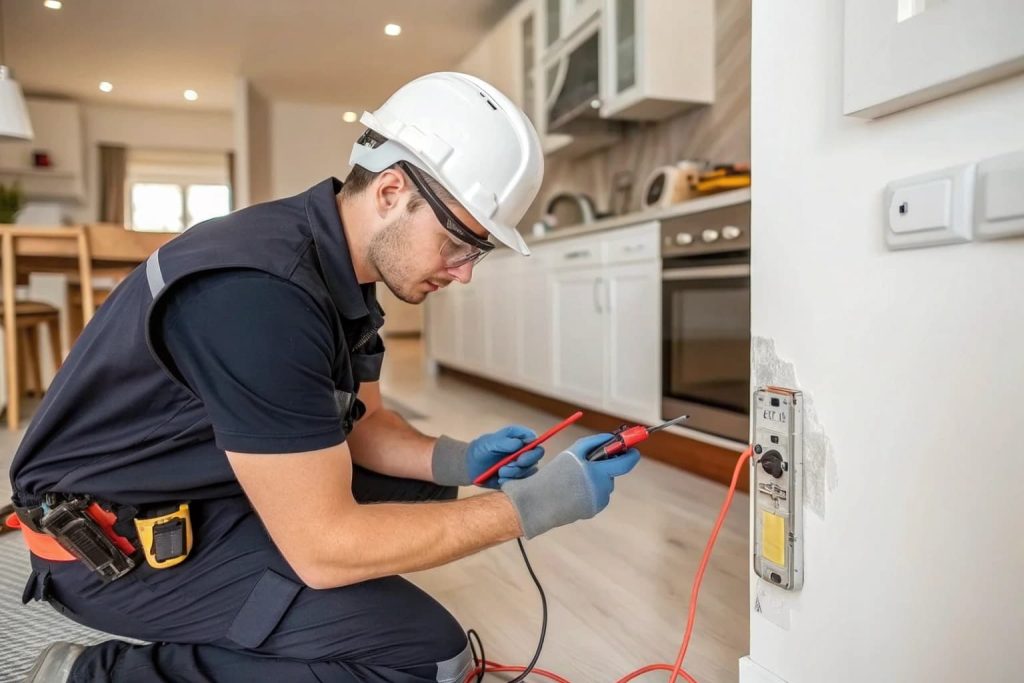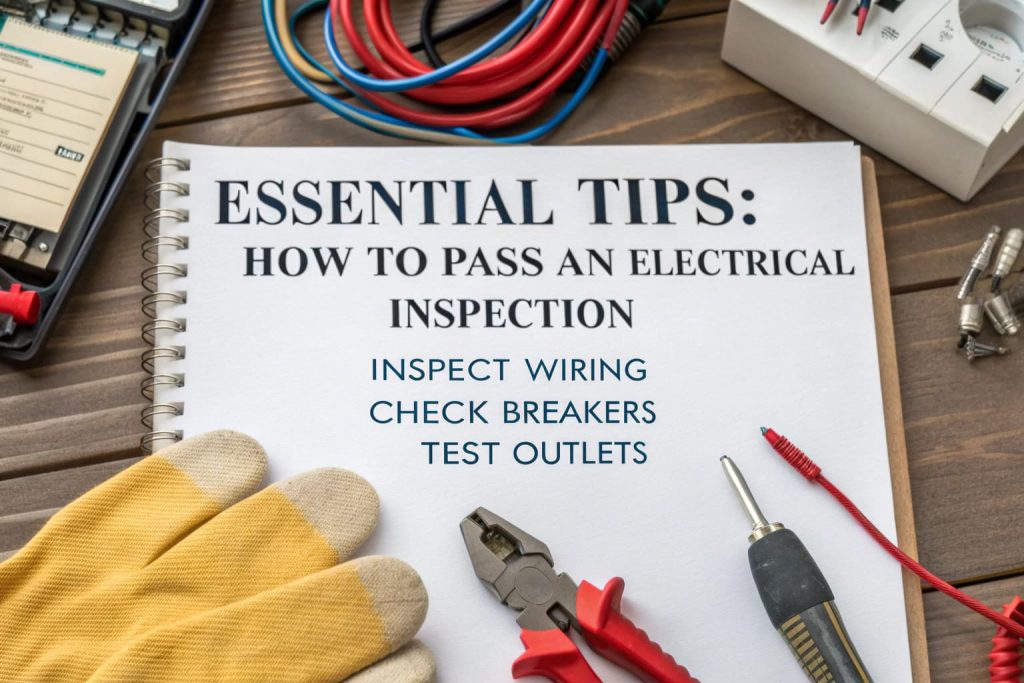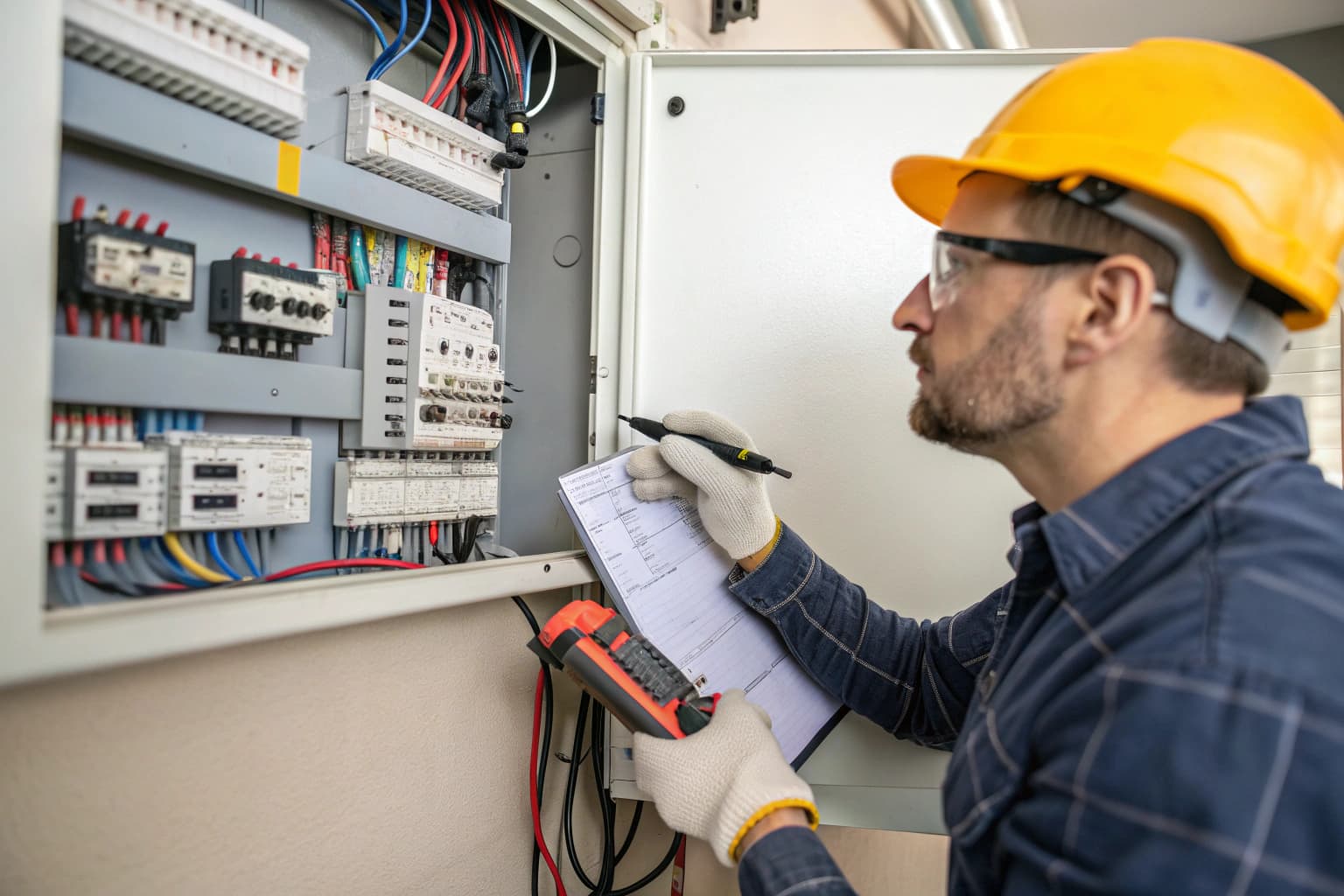Every year, approximately 51,000 home electrical fires occur annually, resulting in nearly 500 deaths, over 1,400 injuries, and approximately $1.3 billion in property damage. These aren’t just statistics-they represent real families, real businesses, and real lives forever changed by preventable electrical hazards. But here’s what most people don’t realize: the majority of these incidents could have been prevented with regular electrical inspections. Professional electrical inspections can identify potential hazards before they become expensive problems, serving as your first line of defense against both financial loss and personal tragedy.
The Hidden Dangers Lurking in Your Electrical System
Ever wondered what’s really happening behind your walls? Your electrical system works tirelessly, 24 hours a day, seven days a week. Like any hardworking system, it experiences wear and tear that isn’t always visible to the untrained eye.
Arcing Faults: The Silent Threat
One of the most dangerous electrical hazards is arcing faults, which account for more than 28,000 home fires annually, causing hundreds of deaths and injuries while generating over $700 million in property damage. These faults occur when electrical current jumps across gaps in damaged wiring, creating intense heat that can ignite surrounding materials. The scary part? Arcing faults often develop gradually, giving no obvious warning signs until it’s too late. Your lights might flicker occasionally, or you might notice a slight burning smell that comes and goes. Most people dismiss these as minor inconveniences, not realizing they’re sitting on a potential powder keg.
Electrical Receptacles: More Dangerous Than You Think
Those innocent-looking outlets throughout your home or office? They contribute to approximately 5,300 fires yearly, resulting in 40 deaths and more than 100 injuries. Overloaded circuits, loose connections, and outdated wiring behind receptacles create perfect conditions for electrical fires. Think about how many devices you plug in daily-phone chargers, computers, kitchen appliances, space heaters. Each connection point represents a potential failure spot, especially in older buildings where electrical systems weren’t designed to handle today’s power demands.
The Aging Infrastructure Problem
Here’s something that might surprise you: electrical distribution systems are the third leading cause of home structure fires. As buildings age, their electrical systems deteriorate in ways that aren’t immediately apparent. Insulation breaks down, connections loosen, and components that were once reliable become potential hazards. Commercial properties face even greater risks due to higher electrical loads and more complex systems. A single electrical failure in a commercial building can shut down operations, damage expensive equipment, and create liability issues that extend far beyond the initial repair costs.
The Critical Role of Electrical Safety Inspections in Fire Prevention

Regular electrical safety inspections serve as your early warning system, identifying problems before they escalate into emergencies. But what exactly happens during these inspections, and why are they so effective?
What Professional Inspectors Look For
Comprehensive electrical safety inspections examine every component of your electrical system, from the main panel to individual outlets. Qualified inspectors perform visual assessments of electrical installations, functional testing of switchgear, insulation resistance tests, and earth continuity checks. This thorough approach ensures that both obvious and hidden problems are identified. During an inspection, professionals check for:
- Overloaded circuits that could lead to overheating
- Damaged or deteriorating wiring insulation
- Improper grounding that increases shock and fire risks
- Outdated electrical panels that can’t handle modern electrical loads
- Faulty GFCI and AFCI protection devices
- Code violations that create safety hazards
The Science Behind Prevention
Annual electrical safety inspections can prevent the majority of electrical fire incidents by catching problems in their early stages. When an inspector identifies loose connections, they’re preventing the heat buildup that leads to fires. When they spot overloaded circuits, they’re stopping the conditions that cause electrical components to fail catastrophically. The inspection process follows strict industry protocols and standards, ensuring that nothing is overlooked. Professional electrical safety inspections use specialized equipment to detect problems that aren’t visible during casual observation, such as thermal imaging cameras that reveal hot spots in electrical panels and connections.
Understanding Different Types of Electrical Inspections
Not all electrical inspections are created equal. Understanding the different types of electrical inspections helps you choose the right service for your specific needs and ensures you’re getting the protection you’re paying for.
Routine Maintenance Inspections
These are the bread and butter of electrical safety-regular checkups that keep your system running smoothly. Various types of electrical inspections serve different purposes in maintaining system safety, and routine maintenance inspections focus on identifying wear and tear before it becomes dangerous. For residential properties, routine inspections typically occur every 3-5 years, though older homes may benefit from more frequent checkups. Commercial properties require specific types of electrical inspections based on their usage, with some high-demand facilities needing annual or even semi-annual inspections.
Code Compliance Inspections
When you’re buying a home, renovating, or dealing with insurance requirements, code compliance inspections ensure your electrical system meets current safety standards. These inspections are particularly important for older properties where electrical systems may not have been updated to meet modern codes. Code compliance inspections examine whether your electrical installation meets local and national electrical codes, identifying any violations that could create safety hazards or legal issues. They’re often required for insurance coverage and can affect your property’s value and marketability.
Specialized Commercial Inspections
Commercial properties face unique electrical challenges that require specialized inspection approaches. High-voltage systems, complex distribution networks, and critical equipment all demand expert attention. Commercial electrical inspections often include power quality analysis, load testing, and evaluation of backup power systems. These inspections are crucial for businesses that depend on reliable electrical power. A single electrical failure can result in lost productivity, damaged equipment, and dissatisfied customers-costs that far exceed the price of regular inspections.
The Financial Benefits: Why Electrical Inspections Pay for Themselves
Let’s talk numbers-because when it comes to electrical inspections, the math is compelling. The investment in routine electrical inspections pays dividends in both safety and savings, often returning many times their cost through prevented problems and improved efficiency.
Preventing Catastrophic Losses
Consider this scenario: a routine electrical inspection costs between $200-$500 for a typical home. Compare that to the average cost of electrical fire damage, which can easily reach tens of thousands of dollars-not to mention the irreplaceable personal items and potential loss of life. Case studies show up to 30% reduction in repair costs when problems are caught early through regular inspections. This isn’t just about avoiding major disasters; it’s about catching small problems before they become expensive ones.
Energy Efficiency Improvements
Old or faulty wiring increases power consumption, and regular maintenance can lead to significant energy cost savings. When electrical connections are loose or components are failing, your system works harder to deliver the same amount of power, driving up your energy bills. Professional inspections identify these efficiency problems, allowing you to address them before they impact your monthly costs. Improved system efficiency through routine inspections can reduce energy consumption by 10-15% in some cases, savings that accumulate month after month.
Equipment Protection
Your electrical system doesn’t just power your lights-it protects expensive equipment throughout your property. Voltage fluctuations, power surges, and other electrical problems can damage computers, appliances, HVAC systems, and other valuable equipment. Regular inspections ensure that protective devices like surge protectors and voltage regulators are functioning properly, safeguarding your investments. The cost of replacing a damaged computer or appliance often exceeds the cost of several years’ worth of electrical inspections.
Insurance Benefits
Many insurance companies offer discounts for properties with documented electrical maintenance programs. Regular inspections demonstrate that you’re taking proactive steps to reduce risk, which insurers reward with lower premiums. More importantly, having current inspection records can be crucial if you ever need to file a claim. Insurance companies may deny claims for electrical fires if they determine that poor maintenance contributed to the problem. Regular inspections provide documentation that you’ve been maintaining your system responsibly.
Essential Tips: How to Pass an Electrical Inspection

Property owners who know how to pass an electrical inspection save time and money by avoiding common pitfalls that lead to failed inspections and costly re-inspections. Learning how to pass an electrical inspection starts with understanding common failure points and addressing them proactively.
Common Inspection Failures
Professional preparation is key to understanding how to pass an electrical inspection successfully. The most common reasons for inspection failures include:
- Overloaded electrical panels with too many circuits
- Missing or improperly installed GFCI outlets in bathrooms, kitchens, and outdoor areas
- Inadequate grounding in older electrical systems
- Improper wire connections and junction boxes
- Outdated electrical panels that don’t meet current codes
Preparation Strategies
Before your inspection, walk through your property and look for obvious problems. Check that all outlets work properly, ensure that circuit breakers aren’t frequently tripping, and verify that GFCI outlets test and reset correctly. Make sure your electrical panel is easily accessible and clearly labeled. Inspectors need to access all areas of your electrical system, so remove any stored items that might block panels, outlets, or electrical equipment. Consider hiring a qualified electrician for a pre-inspection evaluation. They can identify and fix problems before the official inspection, saving you the cost and hassle of failed inspections and re-scheduling.
What to Expect During an Electrical Inspection Process
Understanding what to expect during an electrical inspection helps you prepare properly and ensures you get the most value from the service. The inspection process typically follows a systematic approach that examines every aspect of your electrical system.
Initial Assessment
The inspection begins with a review of your electrical system’s overall condition and configuration. The inspector examines your main electrical panel, checking for proper labeling, adequate capacity, and signs of overheating or damage. They’ll also review any previous inspection reports or electrical work permits to understand your system’s history and identify any ongoing concerns that need attention.
Detailed System Examination
The inspector then conducts a room-by-room examination, testing outlets, switches, and fixtures. They use specialized equipment to measure voltage, check grounding, and identify potential problems that aren’t visible during casual observation. This phase includes testing GFCI and AFCI devices, examining electrical connections, and verifying that installations meet current electrical codes. The inspector documents any problems they find and provides recommendations for addressing them.
Documentation and Reporting
After completing the physical inspection, the inspector prepares a detailed report documenting their findings. This report includes photographs of any problems, specific recommendations for repairs or improvements, and a timeline for addressing critical issues. The report serves as your roadmap for maintaining electrical safety and can be valuable for insurance purposes, property sales, or planning future electrical work.
Why Electrical Inspections for Homeowners Are Non-Negotiable
For homeowners, electrical inspections represent one of the most important investments you can make in your property’s safety and value. Electrical inspections for homeowners are non-negotiable because the risks of neglecting electrical maintenance far outweigh the costs of regular inspections.
Protecting Your Family
Your family’s safety should be your top priority, and electrical hazards pose serious risks that aren’t always obvious. Children are particularly vulnerable to electrical accidents, and electrical fires can spread rapidly, giving families little time to escape safely. Regular inspections provide peace of mind, knowing that qualified professionals have examined your electrical system and identified any potential hazards. This protection is especially important for families with young children, elderly residents, or anyone with mobility limitations who might have difficulty escaping quickly in an emergency.
Maintaining Property Value
Your home is likely your largest investment, and electrical problems can significantly impact its value. Outdated or unsafe electrical systems can make your property difficult to sell and may require expensive updates before a sale can proceed. Regular inspections help maintain your property’s value by ensuring that electrical systems remain safe and up to code. When it’s time to sell, having current inspection records demonstrates that you’ve maintained the property responsibly, making it more attractive to potential buyers.
Meeting Legal and Insurance Requirements
Many jurisdictions require electrical inspections for certain situations, such as home sales, major renovations, or rental properties. Failing to meet these requirements can delay transactions, create legal issues, or result in fines. Insurance companies increasingly require documentation of electrical maintenance, especially for older homes. Regular inspections provide the documentation you need to maintain coverage and may help you qualify for discounts on your premiums.
The Commercial Imperative: Business Continuity and Liability Protection
For business owners, electrical inspections represent a critical component of risk management and operational continuity. Commercial electrical systems face unique challenges that make regular inspections even more important than in residential settings.
Business Continuity Concerns
Electrical failures in commercial settings can shut down operations, resulting in lost revenue, damaged equipment, and dissatisfied customers. The cost of downtime often far exceeds the cost of the electrical repairs themselves, making prevention through regular inspections a smart business investment. Consider a restaurant that loses power during the dinner rush, or a data center that experiences electrical problems affecting multiple clients. These scenarios illustrate why commercial properties require specific types of electrical inspections based on their usage and the critical nature of their electrical systems.
Liability and Legal Protection
Business owners face significant liability risks related to electrical safety. If an electrical problem causes injury to employees or customers, or damage to client property, the resulting lawsuits and insurance claims can be devastating. Regular inspections provide documentation that you’ve taken reasonable steps to maintain electrical safety, which can be crucial in defending against liability claims. They also help ensure compliance with workplace safety regulations and building codes.
Regulatory Compliance
Commercial properties must adhere to specific electrical codes and standards, and regular inspections are mandatory for compliance. Non-compliance can result in fines, forced shutdowns, and legal issues that can seriously impact your business. Inspection requirements vary by industry and location, but most commercial properties need inspections every 3-5 years at minimum. High-risk industries or properties with critical electrical systems may require more frequent inspections.
Making the Smart Choice: Your Next Steps
The evidence is clear: regular electrical inspections save money, prevent disasters, and protect lives. But knowing the benefits is only the first step-taking action is what makes the difference.
Scheduling Your First Inspection
If you haven’t had an electrical inspection in the past three years, or if you’ve never had one, now is the time to schedule one. Don’t wait for warning signs like flickering lights or tripping breakers-by the time these symptoms appear, you may already be at risk. Look for qualified, licensed electrical inspectors with good reputations and proper insurance. Ask for references and verify their credentials with your local licensing board. A quality inspection is an investment in your safety and peace of mind.
Creating a Maintenance Schedule
Once you’ve had your initial inspection, work with your inspector to create a regular maintenance schedule. Most residential properties benefit from inspections every 3-5 years, while commercial properties may need more frequent attention. Mark your calendar and budget for these inspections just like you would for any other important maintenance task. Regular inspections are far more cost-effective than emergency repairs and provide ongoing protection for your property and family.
Taking Action on Recommendations
When your inspection report identifies problems, don’t delay in addressing them. Prioritize safety-critical issues first, but don’t ignore minor problems that could become major ones over time. Work with qualified electricians to make necessary repairs and improvements. Keep detailed records of all electrical work, as this documentation will be valuable for future inspections, insurance purposes, and property sales.

